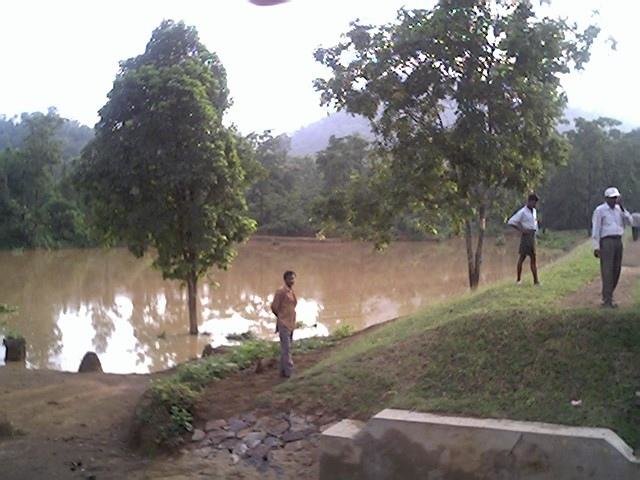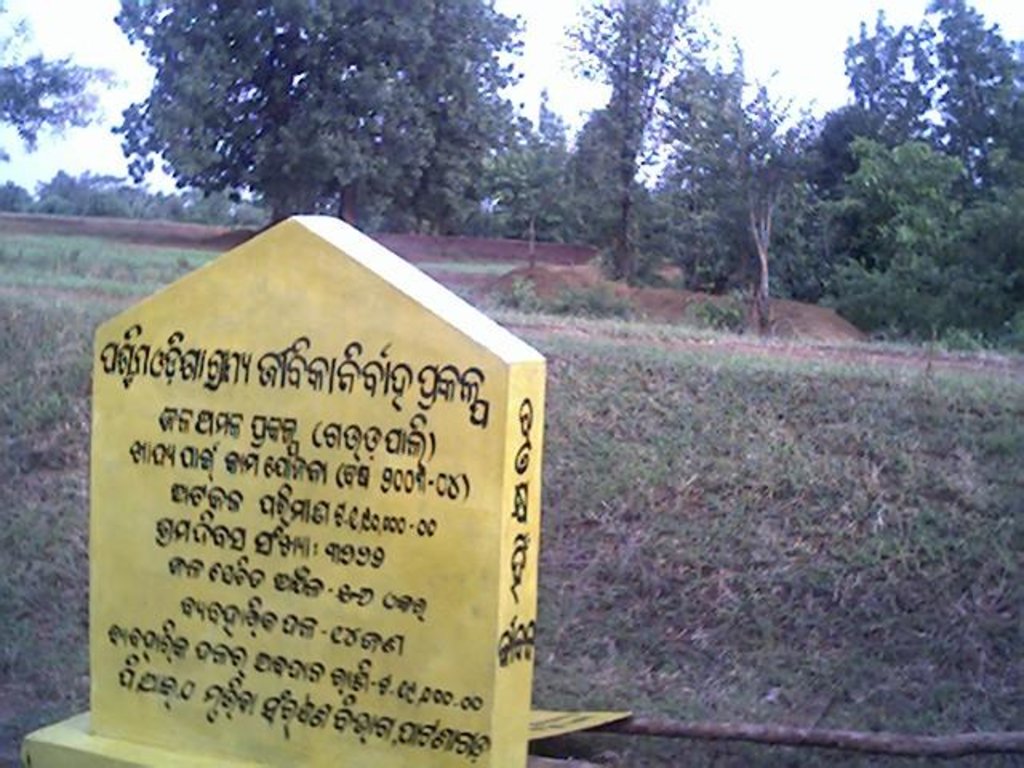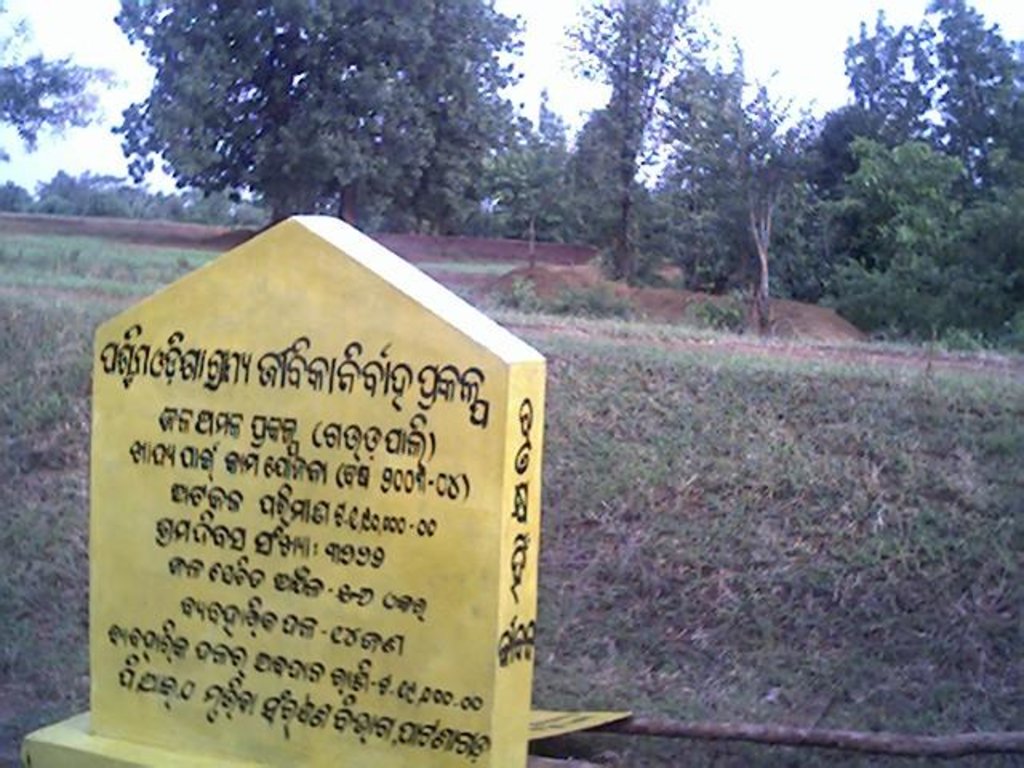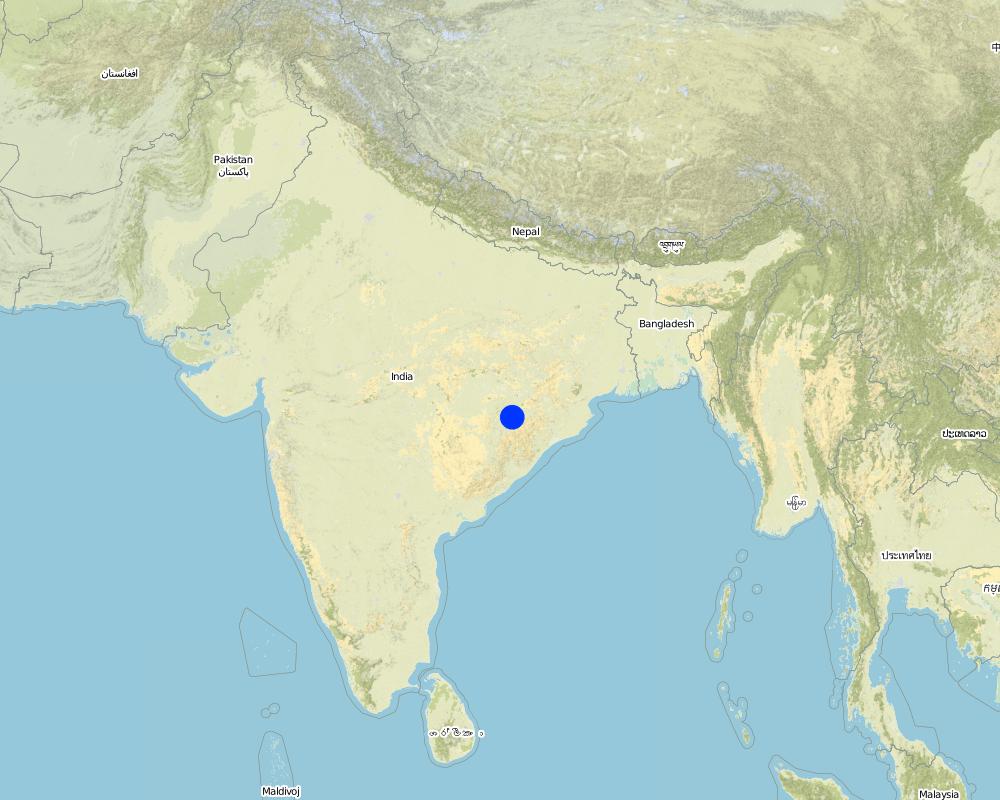Community based sustainable livelihoods [Индия]
- Создание:
- Обновить:
- Составитель: Unknown User
- Редактор: –
- Рецензент: Fabian Ottiger
approaches_2371 - Индия
Просмотреть разделы
Развернуть все Свернуть все1. Общая информация
1.2 Контактные данные специалистов и организаций, участвующих в описании и оценке Подхода
Ответственный (-ые) специалист (-ы)
Специалист по УЗП:
Mohanty Rajib Kumar
Индия
1.3 Условия, регламентирующие использование собранных ВОКАТ данных
Составитель и ответственный/-ые специалист(-ы) согласны с условиями, регламентирующими использование собранных ВОКАТ данных:
Да
1.4 Ссылка (-и) на Анкету (-ы) по Технологиям УЗП

Dug-out sunken pond cum countour bund [Индия]
It can be defined as combination of structural & vegetative measures where contour bunds are constructed from the excavated sandy loam soil of cultivated wastelands in semi-arid climatic(?) zone with moderate slope in medium soil depth conditions in order to link with self-subsistance & market oriented production systems from private …
- Составитель: Unknown User
2. Описание Подхода УЗП
2.1 Краткое описание Подхода
Sustainable livelihoods enhanced through people's organisations by linking with other resource organisations prticularly for resource poor.
2.2 Подробное описание Подхода
Подробное описание Подхода:
Aims / objectives: The name of the project is western orissa rural livelihoods project, supergoal-reduction of poverty in rainfed areas of India, goal- More effective approaches to sustainable rural livelihoods adopted by government agencies & other stakeholders in KBK districts & elsewhere. The overall purpose is sustainable livelihoods, particularly fo the poorest, promoted in 4 districts in replicable ways by 2010 & to reduce poverty by promoting livelihoods initiatives particularly resource poor. Unlike DFID(I)'s earlier rural development projects, WORLP will work within government & follow GOI's watershed guidelines, but extra resources for ' watershed plus' activities: capacity building, minor irrigation, drinking water & livelihood initiatives for the poorest. WORLP is a part of wider effort to help Ministry of Rural Development (MoRD) improve the effectiveness of watershed work nationally;'watershed plus' approach developed in WORLP will be tested for wider replication.
Methods: The project will have basically four types of impact: production impact, employment impact, Poverty alleviation impact & capacity building impact.The project would directly reavh a population of 725,000 people, 80% of whom would be people below poverty line-landless, marginal & small farmers. The Director of the Watershed Mission will answer to an empowered committee chaired by the Chief Secretary; district level will be strenghthened by the appointment of a Project Director-Watershed projects & staff to work alongside the District Rural Development Agencies, funds will be tranferred from the PD-DRDA to the PD-WSP; GoO has appointed full time watershed development teams at block level to support implementation of the KBK plan; WORLP may use these teams, but can also use other government agencies(including Forestry Department in areas with forest land) or NGOs as PIAs. DFID will finance a Project Support Unit at Bhubaneswar, Capacity Building Teams in districts & Livelihood Support Team at block level. The project will fall under state leve Watershed Mission, created to oversee implementation of all MoRDIts main focus is to work with existing strengths & build upon them. In this area 60 to 70% of th population live below official poverty line. Erratic rainfall, limited irrigation, poor capacity of government agencies & restricted opportunities for non-land based activities are major factors. But the key to poverty seems to be the structure of social relations: caste, untouchability, skewed land distribution, land alienation, dependence on money lenders, encroachment on common property resources, gender issues, all of which prevent access by pooe groups to natural resources.
2.3 Фотографии, иллюстрирующие Подход
2.5 Страна/ регион/ место, где применялся Подход
Страна:
Индия
Административная единица (Район/Область):
ORISSA
Map
×2.6 Даты начала и окончания реализации Подхода
Год начала реализации:
2001
Год окончания (Если Подход больше не применяется):
2010
2.7 Тип Подхода
- в рамках проекта/ программы
2.8 Каковы цели/ задачи Подхода
The Approach focused mainly on SLM with other activities (organising the people in general, & poor (defined by the criteria of villagers), analysis of of problems, constraints, opportunities, threat concerning five capitals like physical, social, natural, finacial & human &)
The objectives of the project approach are mainly three components. Promoting livelihoods improvements, capacity building of primary & secondary stakeholders & encouraging an enabling environment.
The SLM Approach addressed the following problems: Coping strategy against Drought, distressed migration, income in the lean period. Other problems are like employment opportunities, farm & non-farm activities for lan users & landless.
2.9 Условия содействующие применению Технологии/ Технологий в рамках Подхода или затрудняющие его
Социальные/ культурные/ религиозные нормы и ценности
- затрудняют
Unity & transparency
Treatment through the SLM Approach: Awareness, training, exposure visits,Regular rapport building etc.
Наличие/ доступность финансовых ресурсов и услуг
- затрудняют
Capital for initiatiation of any activities.
Treatment through the SLM Approach: Project fund
Институциональные условия
- затрудняют
People's organisations not strenghthened
Treatment through the SLM Approach: Formation of institution like Self help group, User group, Watershed committee, Community link workers.
Нормативно-правовая база (землевладение, права на земле- и водопользование)
- затрудняют
Legal provisions like access to Common property resource, rights on assets created etc.
Treatment through the SLM Approach: capacity building on legal provisions.
The existing land ownership, land use rights / water rights moderately hindered the approach implementation operational holdings are highly skewed, appr. 30% of households are landless, & 40-50% are small & marginal farmer, land allienation is wide spread because of indebtedness. Motgaging the land is the outcome due to heavy dependence on private money landers charging unserious rate of interest. Skewed control of land & water. Officially 10% of people own 35% of project area land, inreality appr. 60%
Осведомленность в области УЗП, доступность технической поддержки
- затрудняют
Estimates, lay-out & planning
Treatment through the SLM Approach: Regular training to volunteers to create a bare-foot professionals in the village.
другие
- затрудняют
Community mobilisation
Treatment through the SLM Approach: Common meeting, focus group discussion, adressing household problems.
3. Участие и распределение ролей заинтересованных сторон
3.1 Заинтересованные стороны, участвующие в реализации Подхода и их роли
- местные землепользователи/ местные сообщества
Wok equally divided between men and women (User's group or Area group mainly men, as most of the land is on the name of men. Self help groups are mainly from women. Although women participated in decision making process & also in the activities, but still men take the important decisions particularly for SWC measures. Perhaps mostly the lands are owned by men. Therfore, participation of men in comparison to women for SWC measures is more. In this connection, villagers opine that women participated benevolently for the first time for planting of seedlings. Some landless goup receives uncultivated wate land in meagre amount 0.5 ha whose land is part of the patch. Nextly representative from th resource-poor & very poor category as per the defined criteria of the villagers are also member of the watershed committee. As the watershed committee mainly responsible for any work because the money flows directly to the watershed committee account.
- государственные власти (отвечающие за планирование или принятие решений)
- международные организации
A project implemnting agency is appointed at the block level
Если участвовало несколько заинтересованных сторон, назовите ведущую организацию:
A team of international & national specialist did the study of the four poverty stricken districts of the state. Than they drafted the Project meomrandum which is a broader framework of guidelines stating the robust processes. But it is so flexible in nature that it has every scope for modification as required or desired by the landusers.
3.2 Участие местных землепользователей/ местных сообществ на разных стадиях реализации Подхода
| Участие местных землепользователей/ местных сообществ | Перечислите участников и опишите их вовлеченность | |
|---|---|---|
| инициирование/ мотивация | пассивное | public meetings; People started participating because root cause of every problem becomes clear to the community. Interaction with all villagers again & again through public contacts |
| планирование | пассивное | rapid/participatory rural appraisal; Planning at time of drafting of micro-plan the land users went for transact of the area along with SWC specialist to sense the problem & alternative solutions. |
| выполнение | внешняя поддержка | Mainly: responsibility for minor steps; partly: casual labour; The implementation of the SWC was done by the User's group with supervision of Watershed committee. The Watershed committee provide cheque to the User's group. |
| мониторинг/ оценка | нет | Mainly: measurements/observations; partly: reporting; The monitoring is done at time of measurements/observation by the secretary & watershed committee. The rgular reporting was done by the watershed development team. |
| Research | самоорганизация | on-farm; On-farm demos of the agriculture, integrated nutrient management, intercropping & line sowing etc. |
3.4 Принятие решений по выбору Технологии/ Технологий УЗП
Укажите, кто принимал решение по выбору применяемой Технологии/ Технологий:
- в основном землепользователи при поддержке специалистов по УЗП
Поясните:
Firstly the Project implementing agency & team initiate the discussion in different ways, like training, exposure visits, focused group discussion.The first phase is called rapport building phase for one year, when the livelihood focused micro-plan is prepared. The micro-plan can be modified time to time as per the need & concern of the community.
Decisions on the method of implementing the SLM Technology were made by mainly by land users supported by SLM specialists. In this approach in general & SWC measures in particular, firstly the land user's group raise proposal before the committee. The criteria behind the selection is poor land, poor people, contribution & ridge to valley approach. Than the land users agree to
4. Техническая поддержка, повышение компетенций и управление знаниями
4.1 Повышение компетенций/ обучение
Проводилось ли обучение землепользователей/ других заинтересованных лиц?
Да
Укажите, кто проходил обучение:
- землепользователи
- SWC specialists (1), extensionists/trainers (2), planners (3)
Тип обучения:
- в ходе работы
- обмен опытом между фермерами
- опытные участки
- общие собрания
- курсы
Рассматриваемые темы:
Reconnainance survey through maps. Transact of the area, Identification of root cause of the problem & alternative solution & demonstration of different items so that the land users get a basket of choices. Another objective of the project to develop volunteers who will get some remuneration & help the land users for future maintainance, estimate, lay-out etc.
4.2 Консультационные услуги
Есть ли у землепользователей возможность получать консультации?
Да
Укажите, где именно оказываются консультационные услуги:
- на полях землепользователей
Описание/ комментарий:
Name of method used for advisory service: Community based sustainable livelihoods.; Key elements: Amalgamation of social & natural resource., Agreement of User's grop, benefit sharing, conflict resolution, prioritisation, etc., Farmer to farmer extension, replication through 'learn by doing & teach by showing methods'; 1) Advisory service was carried out through: government's existing extension system, projects own extension structure and agents; Extension staff: mainly government employees 3) Target groups for extension: land users; Activities: Participatory resource mapping through T
Advisory service is inadequate to ensure the continuation of land conservation activities; It is because it is really to early to conclude about extention. It requires high degree of common sense & commitment. Although extension service is in place but it needs coordination & management which will be hopefully developed by the project within next 3-4 years.
4.3 Институциональная (организационная) поддержка
В ходе реализации Подхода были ли организованы новые институциональные структуры или поддержаны уже существующие?
- да, существенно
Укажите уровень, на котором структуры были укреплены или вновь созданы:
- местные
Укажите тип поддержки:
- финансовая
- повышение компетенций/ обучение
- оборудование
4.4 Мониторинг и оценка
Являются ли мониторинг и оценка частью Подхода?
Да
Комментарии:
bio-physical aspects were regular monitored through observations
technical aspects were regular monitored through observation
socio-cultural aspects were ad hoc monitored through observations
economic / production aspects were ad hoc monitored through observations
There were many changes in the Approach as a result of monitoring and evaluation: By timely monitoring & evaluation, the stages of the linked institutions are determined & capacity building was determined time to time. Fo example a training to SWC/NRM volunteers, supervision was done after regular interval. Than again after a time period the refresher training was devised as per the receptance of the concerned volunteers.
4.5 Научные исследования
Были ли научные исследования частью Подхода?
Да
Укажите темы исследований:
- социология
- экономика / маркетинг
- технология
Напишите подробнее и назовите тех, кто выполнял исследования:
Participatory technology development with proper admixture of social & natural resouce is one of the objective of the project. As the components of technology, social dynamics & economics are interwoven with each other, therefore, research through consultants of national & international repute is a regular part of the project process.
Research was carried out on-farm
5. Финансирование и внешняя материальная поддержка
5.1 Годовой бюджет мероприятий по УЗП в рамках Подхода
Если точный годовой бюжет неизвестен, укажите примерный диапазон затрат:
- < 2000
Комментарий (например, основные источники финансирования/ ключевые доноры):
Approach costs were met by the following donors: international (DFID): 100.0%
5.2 Финансирование и внешняя материальная поддержка, предоставляемая землепользователям
Предоставлялась ли землепользователям финансовая/ материальная поддержка для применения Технологии /Технологий?
Да
5.3 Субсидии на отдельные затраты (включая оплату труда)
- оборудование
| Укажите, какие ресурсы были субсидированы | В какой степени | Опишите субсидии подробнее |
|---|---|---|
| инвентарь/ инструменты | профинансированы частично | |
- сельскохозяйственные
| Укажите, какие ресурсы были субсидированы | В какой степени | Опишите субсидии подробнее |
|---|---|---|
| Seedlings | профинансированы полностью | |
- инфраструктура
| Укажите, какие ресурсы были субсидированы | В какой степени | Опишите субсидии подробнее |
|---|---|---|
| Community infrastructure | профинансированы полностью | |
Комментарии:
The unit of the project is a watershed & the project cost is rs. 9,500 per hac, out of which around rs. 3,600/ is for direct SWC measures & rest is for enhancement of livelihood assets & linking to self-sustainable institutions.
5.4 Кредитование
Предоставлялись ли в рамках Подхода кредиты на мероприятия УЗП?
Да
Укажите условия предоставления (процент, окупаемость и т.д.):
Interest rate charged: 8.0%; repayment conditions: From the project side it one time grant to the watershed committee. But the watershed committee gives loan to groups or individual as per their own norms & condition. As the the project is trying to have a revolving fund in the watershed level for future mainatinance & requirement..
Interest was lower than market rate.
Перечислите заёмщиков:
The person who will avail loan must be in aself help group & must pass through the grading process w
6. Анализ влияния и заключительные положения
6.1 Влияние Подхода
Сумел ли Подход помочь землепользователям внедрить и поддерживать технологии УЗП?
- Нет
- Да, немного
- Да, умеренно
- Да, существенно
The crop-diversification like change from the minor millets to cash crop & paddy. The land where only one crop season, but now they are taking up two crops, like kharif & pre-Rabi crops etc.
Сумел ли Подход разрешить правовые проблемы землевладения/ землепользования, препятствующие использованию технологий УЗП?
- Нет
- Да, немного
- Да, умеренно
- Да, существенно
Villagers are classified under 4 categories, well-off, manageable, poor & very poor as per the criteria developed by villagers. For the project norms except well-off all are target group. At that time the contribution from a resource rich farmer was collected cash. The resource poor farmers were given a period of time & collected out of contribution of labour.
Did other land users / projects adopt the Approach?
- Нет
- Да, немного
- Да, умеренно
- Да, существенно
It is very difficult to quntify in this stage. But the reprentatives of nearly 15 Project areas visited under exposure visits. The Project implementing agencies of other districts states also visted & learnt the technology & outcome of the technology in form of production from the land, crop-diversification.
6.3 Долгосрочная устойчивость мероприятий в рамках Подхода
Могут ли землепользователи самостоятельно (без внешней поддержки) продолжать применение того, что было реализовано в рамках Подхода?
- нет уверенности
Если нет или нет уверенности, объясните почему:
It is because although it was hoped but one project cycle of 5 years is not over to give concluding remarks.
6.4 Сильные стороны/ преимущества Подхода
| Сильные стороны/ преимущества/ возможности по мнению составителя или других ключевых специалистов |
|---|
| Equity in investments, with a particular focus on developing SWC on the land of small & marginal farmers, often in the upper catchment. (How to sustain/ enhance this strength: The review & montoring as per the micro-plan developed by the villagers of the watershed.) |
| Generating employment for those most in need in the early phases to provide immediate relief from indebtedness & impoverishment & need to migrate. |
| A group approach built around the establishment of revolving fundsto provide alternative credit sources. Site specific approaches ranging from rainfed SWC measures to increasing |
7. Справочные материалы и ссылки
7.1 Методы сбора/источники информации
- выезды на места, полевые обследования
- опросы землепользователей
Ссылки и модули
Развернуть все Свернуть всеСсылки

Dug-out sunken pond cum countour bund [Индия]
It can be defined as combination of structural & vegetative measures where contour bunds are constructed from the excavated sandy loam soil of cultivated wastelands in semi-arid climatic(?) zone with moderate slope in medium soil depth conditions in order to link with self-subsistance & market oriented production systems from private …
- Составитель: Unknown User
Модули
Нет модулей





